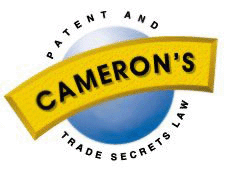
Amfac Foods Inc. et al v.
Irving Pulp & Paper, Ltd.
citation(s): (1987) 12 C.P.R. (3d) 193 (F.C.A. per Urie J.).
 |
Amfac Foods Inc. et al v.
|
copyright 1997-2007 Donald M. Cameron
"First, I agree with the respondent that the issue involves solely the construction of the patent and, in conformity with normal rules of claim construction, no reference to the prior art is either required or proper in this case.
I turn next to the other three disputed areas. As in any patent action, the specification must be construed as a whole. The disclosure portion describes the invention for which the monopoly is claimed. The claims define the scope thereof. Since the invalidity of claim 16 found by the trial judge was based on his finding that the claim is broader than the invention disclosed, the nature of that invention should first be ascertained from the disclosure in the specification. The opening paragraph of the specification reads as follows:
This invention is directed to an improved method and means for the slicing of vegetables, and is particularly concerned with the slicing of potatoes for the production of so called French fried or string potatoes. The invention enables attainment of a maximum yield of long, uniform cross-sectional area cuts. In other words, slicing is performed longitudinally or lengthwise of the potato in a uniform and accurate manner so that the resultant cuts represent the maximum lengths obtainable, limited only by the length size of the type of potato being processed. At the same time, the less desirable outside cuts or portions of the potato, herein referred to as the "slab" portions, are sliced from the sides and removed from the subject center cuts. The latter simultaneouly diverted to other uses, such as that aspect of plant processing involving dehydration of these less desirable portions for preparation as dehydrated mashed potatoes. The invention permits of mass production involving relatively huge amounts of potatoes processed, since the operation is performed hydraulically at extreme speed, with the more desirable center cuts being efficiently sliced in uniform fashion and with minimum or complete lack of damage to the cellular structure of the potato.
The importance of slabbing and separate removal of the undesirable outside cuts to achieve desired result of long, uniform center cuts of potatoes for french fries, is made plain throughout the disclosure, as Strayer J. found. The following excerpts provide examples thereof:
The instant invention overcomes these and many other difficulties. The invention, as stated, enables not only extremely rapid and efficient cutting into strips or slices of predetermined size, but eliminates from the final product those portions of the potato which from(sic) a purity and taste standpoint should in any event be eliminated; the skin, some of which remains after even the most efficient of previous methods are used for mass peeling of potatoes; the eyes, and as well, other ordinary imperfections common to the tuber.
It is accordingly a primary objective of this invention to provide a means, and a method of operation of same, which achieves a uniform and even slicing of vegetable products, particularly the potato, thus obtaining as one example, frenched potatoes from the center of the tuber which represent the true over-all length thereof, and which are of standard dimension and uniform in cross-sectional size. . . . . .
Another object of the invention is the provision of a device which will permit removal of the four exterior sizable slabs from the potato, leaving only long rectangular interior sections which are simultaneously cut from the center and primarily used for frenched potatoes.
Without discussing the applicability of s-s. 38(1), as earlier stated, it is my view that a fair reading of the specification does not support the appellants' view of the nature of the invention. The excerpts from the specification to which I have earlier referred support Strayer J.'s finding as to the nature of the invention. In fact, in my opinion, a fair analysis of the disclosure and of the claims permit no other view. There is one invention only, not two. The cutting and separation of the outside slabs are essential to the invention, not a preferred embodiment thereof."
Return to:
Cameron's IT Law: Home Page; Index
Cameron's Canadian Patent & Trade Secrets Law: Home Page; Index